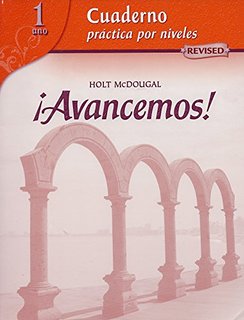
All Solutions
Page 374: Gramatica B
Hint: Look at the noun. Demonstration adjectives match with the noun in number and gender.
– …**estos** aretes.
*(I bought these earrings.)*
*”Aretes”* is a masculine noun in plural, so the demonstrative adjective has *”-os*” at the end.
– …**aquel** collar de oro.
*(Luis bought that golden necklace.)*
*”Collar”* is a masculine noun in singular and the demonstration adjective is *”aquel.”*
– …**estas** artesanías.
*(Marta bought these handicrafts.)*
*”Artesanías”* is a feminine noun in plural, so the demonstrative adjective has *”-as*” at the end.
– …**esa** joya.
*(My friends bought that jewelry.)*
*”Joya”* is a feminine noun in singular, so the demonstrative adjective we used is *”esa.”*
– …**aquellos** recuerdos para ustedes.
*(My sister bought those souvenirs for you.)*
*”Recusrdos”* is a masculine noun in plural, so the demonstrative adjective has *”-os*” at the end.
1. B
2. C
3. C
4. B
5. D
– *este/esta/esto – this* and *estos/estas – these* to refer to things that are **near (cerca)**
– *ese/esa/eso – that* and *esos/esas – those* to refer to things that are **far (lejos)**
**N.B.** Remember that demonstration adjectives match with the noun in number and gender.
– …**estos** recuerdos.
*(I saw those souvenirs.)*
*”Recuerdos”* is a masculine noun in plural, so the demonstrative adjective has *”-os*” at the end.
*”Estos”* implies the souvenirs are near.
– …**estas** artesanías.
*(We bought these handicrafts.)*
*”Artesanías”* is a feminine noun in plural, so the demonstrative adjective has *”-as*” at the end.
*”Estas”* means that the handicrafts are near.
– ….**esas** joyas.
*(My sister bought those pieces of jewelry.)*
*”Joyas”* is a feminine noun in plural, so the demonstrative adjective has *”-as*” at the end.
*”Esas”* means that the pieces of jewelry are far.
– …**ese** anillo de plata.
*(You bought that silver ring.)*
*”Anillo”* is a masculine noun in singular, so the demonstrative adjective is *”ese.”*
*”Ese”* implies the ring is far.
– …**este** artículo de madera.
*(Ivan bought this wooden handicraft.)*
*”Artículo de madera”* is a masculine noun in singular, so the demonstrative adjective is *”este.”*
*”Este”* implies the handicraft is near.
1. estos
2. estas
3. esas
4. ese
5. este
**N.B.** Remember that the demonstrative adjectives match the number and gender of the noun.
– Nosotros podemos comprar **aquellos** aretes en el mercado de artesanías.
*(We can buy those earrings at the handicrafts market.)*
*”Aretes”* is a masculine noun in plural, so the demonstrative adjective has *”-os*” at the end.
*”Aquellos”* means that the earrings are very far.
– Nosotros podemos comprar **estos** recuerdos en el mercado de artesanías.
*(We can buy these souvenirs at the handicrafts market.)*
*”Recuerdos”* is a masculine noun in plural, therefore, the demonstrative adjective has *”-os*” at the end.
*”Estos”* implies the souvenirs are near.
– Nosotros podemos comprar **esas** artesanías en el mercado de artesanías.
*(We can buy those handicrafts at the handicrafts market.)*
*”Artesanías”* is a feminine noun in plural, so the demonstrative adjective has *”-as*” at the end.
*”Esas”* means that the handicrafts are far.

